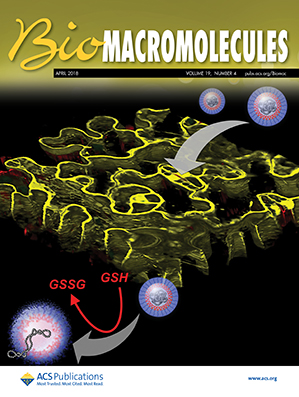Dielectric Properties of Wood-Derived Cellulose Nanofiber Films in 10–40 GHz Band
IF 5.4
2区 化学
Q1 BIOCHEMISTRY & MOLECULAR BIOLOGY
引用次数: 0
Abstract
Wood-derived cellulose nanofiber (CNF) offers excellent electrical insulation, mechanical strength, flexibility, thermal stability, and low thermal expansion, meeting the growing demand for sustainable materials in electronic devices. However, the dielectric properties of CNF-based material crucial for beyond-fifth-generation (B5G) applications at frequencies above 10 GHz remain underexplored. This study investigates dielectric behaviors of CNF films with varying surface functional groups and porosities over 10–40 GHz under controlled humidity. Carboxylated CNF films exhibited distinct dielectric characteristics compared to noncarboxylated CNFs, with moisture sensitivity significantly reduced by substituting proton counterions with hydrophobic tetra-n-butylammonium. Increased porosity led to linear decrease in relative permittivity but increase in loss tangent. The intrinsic permittivity of CNFs also decreased with larger Scherrer crystal size. These findings demonstrate that controlling interfacial polarization and interfibrillar interactions effectively lowers the dielectric response of CNF films, highlighting their potential in B5G and high-frequency electronic applications.
- Download: Download high-res image (68KB)
- Download: Download full-size image
木源纤维素纳米纤维薄膜在10- 40ghz频段的介电性能
木材衍生的纤维素纳米纤维(CNF)具有优异的电绝缘性、机械强度、柔韧性、热稳定性和低热膨胀性能,满足了电子设备对可持续材料日益增长的需求。然而,对于超过第五代(B5G)应用频率高于10ghz的cnf基材料的介电特性仍未得到充分探索。本文研究了具有不同表面官能团和孔隙率的CNF薄膜在湿度控制下的介电行为。与非羧基化CNF膜相比,羧基化CNF膜表现出明显的介电特性,用疏水性四正丁基铵取代质子反离子显著降低了膜的水分敏感性。孔隙度增加导致相对介电常数线性下降,但损耗正切增大。碳纳米管的固有介电常数也随舍勒晶体尺寸的增大而减小。这些发现表明,控制界面极化和纤维间相互作用有效地降低了CNF薄膜的介电响应,突出了它们在B5G和高频电子应用中的潜力。
本文章由计算机程序翻译,如有差异,请以英文原文为准。
求助全文
约1分钟内获得全文
求助全文
来源期刊

Biomacromolecules
化学-高分子科学
CiteScore
10.60
自引率
4.80%
发文量
417
审稿时长
1.6 months
期刊介绍:
Biomacromolecules is a leading forum for the dissemination of cutting-edge research at the interface of polymer science and biology. Submissions to Biomacromolecules should contain strong elements of innovation in terms of macromolecular design, synthesis and characterization, or in the application of polymer materials to biology and medicine.
Topics covered by Biomacromolecules include, but are not exclusively limited to: sustainable polymers, polymers based on natural and renewable resources, degradable polymers, polymer conjugates, polymeric drugs, polymers in biocatalysis, biomacromolecular assembly, biomimetic polymers, polymer-biomineral hybrids, biomimetic-polymer processing, polymer recycling, bioactive polymer surfaces, original polymer design for biomedical applications such as immunotherapy, drug delivery, gene delivery, antimicrobial applications, diagnostic imaging and biosensing, polymers in tissue engineering and regenerative medicine, polymeric scaffolds and hydrogels for cell culture and delivery.
 求助内容:
求助内容: 应助结果提醒方式:
应助结果提醒方式:


